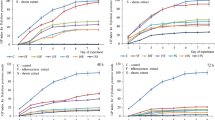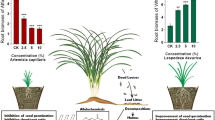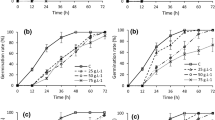Abstract
Allelopathy is very important for the scientific disposition of garden plants. To understand the allelopathic potential of Koelreuteria bipinnata Franch. var. integrifoliola, the germination of Agrostis tenuis Sibth., Festuca arundinacea Schreb. and Lolium perenne L. were determined under laboratory conditions. The results showed that root, stem and leaf aqueous extracts of K. bipinnata var. integrifoliola had allelopathic effects on all three turf grasses, and the allelopathic activity varied according to extract concentrations, test species, and extract sources. Lower extract concentrations did not affect or promoted the germination and initial seedling growth of turf grasses, but the highest concentrations almost had inhibitory effect. The order of allelopathic potentials of the three organs on germination of these receptors was root < stem < leaf. And at the highest concentration of leaf extract, the most strongly inhibition was found in A. tenuis, followed by F. arundinaces and then L. perenne. In addition, according to gas chromatography–mass spectrometry (GC–MS) analysis, the allelopathic potential compounds and their abundance in root, stem and leaf were obviously different. Therefore, the allelopathic compounds may responsible for allelopathy of K. bipinnata var. integrifoliola. These findings suggested that more attention should be paid to the leaf of K. bipinnata var. integrifoliola for the relative higher allelopathic effects.
Similar content being viewed by others
Abbreviations
- GC–MS:
-
gas chromatography–mass spectrometry
References
Rice, E.L., Allelopathy, New York: Academic, 1984.
Weidenhamer, J.D., Biomimetic measurement of allelochemical dynamics in the rhizosphere, J. Chem. Ecol., 2005, vol. 31, pp. 221–236.
Berenbaum, M., Brementown revisited: interaction among allelochemicals in plants, Recent Adv. Phytochem., 1985, vol. 19, pp. 139–169.
Ahmed, R., Hoque, A.T.M.R., and Hossain, M.K., Allelopathic effects of leaf litters of Eucalyptus camaldulensis on some forest and agricultural crops, J. For. Res., 2008, vol. 19, pp. 19–24.
Vyvyan, J.R., Allelochemicals as leads for new herbicides and agrochemicals, Tetrahedron, 2002, vol. 58, pp. 1631–1646.
Braine, J.W., Curcio, G.R., Wachowicz, C.M., and Hansel, F.A., Allelopathic effects of Araucaria angustifolia needle extracts in the growth of Lactuca sativa seeds, J. For. Res., 2012, vol. 17, pp. 440–445.
Valeraburgos, J., Díazbarradas, M.C., and Zunzunegui, M., Effects of Pinus pinea litter on seed germination and seedling performance of three Mediterranean shrub species, Plant Growth Regul., 2012, vol. 68, pp. 285–292.
Luo, Z., Tian, D., Ning, C., Yan, W., Xiang, W., and Peng, C., Roles of Koelreuteria bipinnata as a suitable accumulator tree species in remediating Mn, Zn, Pb, and Cd pollution on Mn mining wastelands in southern China, Environ. Earth Sci., 2015, vol. 4, pp. 379–382.
Decraene, L.P.R., Smets, E., and Clinckemaillie, D., Floral ontogeny and anatomy in Koelreuteria with special emphasis on monosymmetry and septal cavities, Plant Syst. Evol., 2000, vol. 223, pp. 91–107.
Cao, M.X., Huang, J.Q., He, Y.L., Liu, S.J., Wang, C.L., Jiang, W.Z., and Wei, Z.M., Transformation of recalcitrant turfgrass cultivars through improvement of tissue culture and selection regime, Plant Cell Tissue Organ Cult., 2006, vol. 85, pp. 307–316.
Pathan, S.M., Aylmore, L.A.G., and Colmer, T.D., Soil properties and turf growth on a sandy soil amended with fly ash, Plant Soil, 2003, vol. 256, pp. 103–114.
Facelli, J.M., Multiple indirect effects of plant litter affect the establishment of woody seedlings in old fields, Ecology, 1994, vol. 75, pp. 1727–1735.
Li, X.F., Wang, J., Huang, D., Wang, L.X., and Wang, K., Allelopathic potential of Artemisia frigida and successional changes of plant communities in the northern China steppe, Plant Soil, 2011, vol. 341, pp. 383–398.
Kohli, R.K., Batish, D., and Singh, H.P., Allelopathy and its implications in agroecosystems, J. Crop Prod., 2008, vol. 1, pp. 169–202.
Fitter, A., Making allelopathy respectable, Science, 2003, vol. 301, pp. 1337–1338.
Liu, Q., Lu, D., Jin, H., Yan, Z., Li, X., Yang, X., Guo, H., and Qin, B., Allelochemicals in the rhizosphere soil of Euphorbia himalayensis, J. Agr. Food Chem., 2014, vol. 62, pp. 8555–8561.
Mutlu, S. and Atici, Ö., Allelopathic effect of Nepeta meyeri Benth. extracts on seed germination and seedling growth of some crop plants, Acta Physiol. Plant., 2009, vol. 31, pp. 89–93.
Williamson, G.B. and Weidenhamer, J.D., Bacterial degradation of juglone, J. Chem. Ecol., 1990, vol. 16, pp. 1739–1742.
Zhang, Y., Tang, S., Liu, K., Li, X., Huang, D., and Wang, K., The allelopathic effect of Potentilla acaulis on the changes of plant community in grassland, northern China, Ecol. Res., 2015, vol. 30, pp. 41–47.
Shui, J., An, Y., Ma, Y., and Ichizen, N., Allelopathic potential of switchgrass (Panicum virgatum L.) on perennial ryegrass (Lolium perenne L.) and alfalfa (Medicago sativa L.), Environ. Manag., 2010, vol. 46, pp. 590–598.
Ding, L., Jing, H.W., Wang, T., Li, J., and Liu, G.A., Regulation of root growth in Lactuca sativa L. seedlings by the ent-kaurane diterpenoid epinodosin, J. Plant Growth Regul., 2010, vol. 29, pp. 419–427.
Monica, D. and Don, C., Leaf and root extracts of the invasive shrub, Lonicera maackii, inhibit seed germination of three herbs with no autotoxic effects, Plant Ecol., 2006, vol. 184, pp. 287–296.
Ghebrehiwot, H.M., Aremu, A.O., and van Staden, J.V., Evaluation of the allelopathic potential of five South African mesic grassland species, Plant Growth Regul., 2014, vol. 72, pp. 155–162.
Li, Z.H., Wang, Q., Ruan, X., Pan, C.D., and Jiang, D.A., Phenolics and plant allelopathy, Molecules, 2010, vol. 15, pp. 8933–8952.
Ossipov, V., Nurmi, K., Loponen, J., Prokopiev, N., Haukioja, E., and Pihlaja, K., HPLC isolation and identification of flavonoids from white birch Betula pubescens leaves, Biochem. Syst. Ecol., 1995, vol. 23, pp. 213–222.
Tefera, T., Allelopathic effects of Parthenium hysterophorus extracts on seed germination and seedling growth of Eragrostis tef, J. Agron. Crop Sci., 2002, vol. 188, pp. 306–310.
Greer, M.J., Wilson, G.W.T., Hickman, K.R., and Wilson, S.M., Experimental evidence that invasive grasses use allelopathic biochemicals as a potential mechanism for invasion: chemical warfare in nature, Plant Soil, 2014, vol. 385, pp. 165–179.
Viard-Crétat, F., Baptist, F., Secher-Fromell, H., and Gallet, C., The allelopathic effects of Festuca paniculata, depend on competition in subalpine grasslands, Plant Ecol., 2012, vol. 213, pp. 1963–1973.
Author information
Authors and Affiliations
Corresponding author
Additional information
The article is published in the original.
Rights and permissions
About this article
Cite this article
Zhang, X., Cui, Q.X., Zhao, Y. et al. Allelopathic Potential of Koelreuteria bipinnata var. integrifoliola on Germination of Three Turf Grasses. Russ J Plant Physiol 65, 833–841 (2018). https://doi.org/10.1134/S1021443718060146
Received:
Published:
Issue Date:
DOI: https://doi.org/10.1134/S1021443718060146




